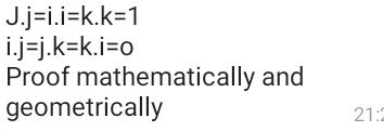
|
|

|
All Questions Topic List |
VectorQuestion and Answers: Page 6 |
Question Number 128830 Answers: 2 Comments: 0
|

|
Question Number 128347 Answers: 0 Comments: 0
|
| E is a vectorial space wich has as base
(i^→ ,j^→ ,k^→ ).
P={ ((x),(y),(( z)) ) such that 5x+y+z=0}
1. Determinate one base of P.
|
|
Question Number 128314 Answers: 2 Comments: 0
|
| ∫_0 ^( ∞) ((sin(px))/( (√x))) dx
∀p∈R
|
|
Question Number 128245 Answers: 1 Comments: 0
|
| nice calculus...
prove that :: ∫_0 ^( (π/4)) xcot(x)dx=(1/2)(G+(π/4)log(2))
|
|
Question Number 127568 Answers: 0 Comments: 1
|

|
Question Number 127566 Answers: 1 Comments: 0
|

|
Question Number 126786 Answers: 1 Comments: 0
|

|
Question Number 126778 Answers: 2 Comments: 0
|

|
Question Number 126716 Answers: 1 Comments: 0
|

|
Question Number 126627 Answers: 0 Comments: 0
|

|
Question Number 126567 Answers: 1 Comments: 0
|

|
Question Number 126614 Answers: 0 Comments: 0
|

|
Question Number 126523 Answers: 0 Comments: 0
|

|
Question Number 126481 Answers: 0 Comments: 0
|

|
Question Number 126475 Answers: 1 Comments: 0
|

|
Question Number 126442 Answers: 0 Comments: 0
|
| maximum value of direction derivative of Φ:e^(3x) sin(yz^4 )at(0 ,π/4, 1) is?
|
|
Question Number 126414 Answers: 1 Comments: 0
|

|
Question Number 126398 Answers: 0 Comments: 0
|
| r^→ (t)=4sin^2 ti^→ +4cos^2 tj^→ −3k^→
|
|
Question Number 125662 Answers: 1 Comments: 0
|
| I = ∫_0 ^4 tanh^(−1) 2x dx = ???
|
|
Question Number 124131 Answers: 1 Comments: 0
|

|
Question Number 123876 Answers: 3 Comments: 0
|
| Find the distance from the
point S(1,1,5) to the line
L : { ((x=1+t)),((y=3−t )),((z=2t)) :}.
|
|
Question Number 123115 Answers: 0 Comments: 1
|
| Σ_(n=1) ^∞ 2^n =?
|
|
Question Number 122579 Answers: 1 Comments: 0
|

|
Question Number 120801 Answers: 1 Comments: 2
|

|
Question Number 120258 Answers: 1 Comments: 0
|

|
Question Number 118411 Answers: 1 Comments: 0
|
| Write the vector v=(1,−2,3) as a
linear combination of vectors
u_1 =(1,1,1) ,u_2 =(1,2,3) and u_3 =(2,−1,1)
|
|
Pg 1
Pg 2
Pg 3
Pg 4
Pg 5
Pg 6
Pg 7
Pg 8
Pg 9
Pg 10
|
Terms of Service |
Privacy Policy |
Contact: info@tinkutara.com |


































